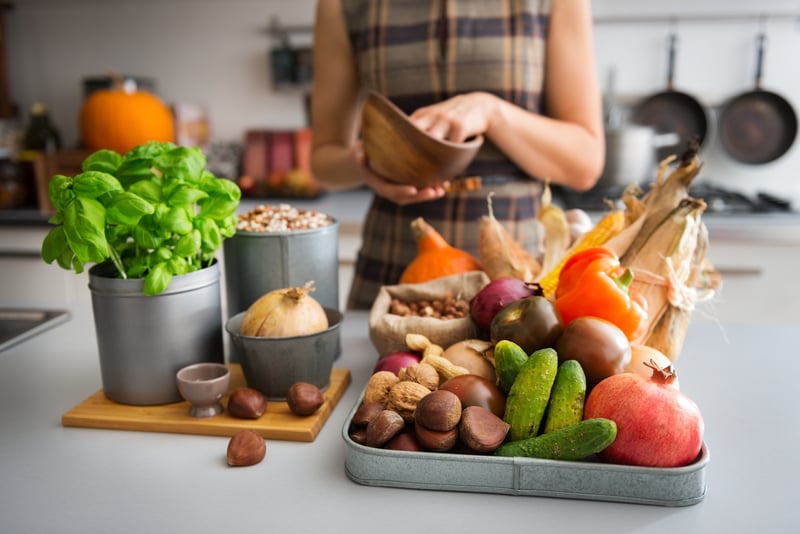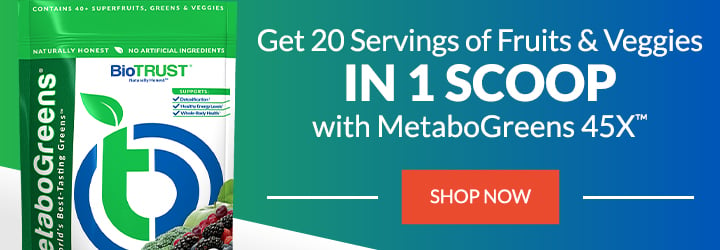The 29 Most Nutritious Fall Fruits and Vegetables

As the season transitions from summer into fall, it’s time to embrace change. Summer heat fades, and a chill begins to linger. The smell of fresh cut grass is replaced with the earthy scent of fallen leaves. And anticipation grows as the holiday season approaches. But one of the best changes fall brings is food! Now don’t get me wrong: I love my summer veggies from the garden, but fall fruits and vegetables brings a whole new array of flavors that are perfect for changing up the menu.
When I think of fall foods, I immediately begin thinking about cozy soups, roasted veggies, yummy bakes, and most importantly… pumpkin! Pumpkin is quintessential to all things fall, but while I do love all things pumpkin myself, we can’t neglect the many other delicious and nutritious options. From figs to fennel, fall is filled with fantastic seasonal produce.
Here are some of the most nutritious fall fruits and vegetables to start gathering now:
29 Nutritious Fall Fruits and Vegetables
1. Apples
From going apple picking to getting snug with a warm mug of cider, apples perfectly embody fall. Beyond this, though, apples are known for their health benefits. Apples are filled with water-soluble fiber, a mix of polyphenols, and vitamin C.
Since they contain plenty of soluble fiber, apples may also lower your risk of heart disease by helping lower blood cholesterol levels. Keep in mind, though, when eating an apple, it’s best to eat them in their whole form, skin included, as the skin contains high concentrations of antioxidants.
2. Artichokes
Artichokes are considered an early fall vegetable since this is when they produce their second harvest. Artichokes are packed with heart-protective nutrients and antioxidants, including anthocyanins, cynarin, and silymarin.
3. Arugula
Although it can be grown year-round, arugula is typically considered a fall vegetable. It is a healthful leafy green with a peppery taste and is full of antioxidants, glucosinolates, and vitamin K.
4. Beets
Beets are also available year-round, but their flavor is richest in fall. Beets can be vibrantly red or yellow in color and contain betalain, a phytonutrient that has antioxidant and anti-inflammatory benefits. Beets are also a good source of folate, potassium, and manganese, which helps with calcium absorption and blood clotting.
5. Broccoli
Broccoli grows well into the beginning of fall and is full of healthful nutrients. One serving of broccoli contains 10% of your daily dose of dietary fiber. In addition, it also contains iron, potassium, calcium, selenium, and magnesium as well as vitamins A, C, E, K, and an array of B vitamins.
6. Brussel Sprouts
Brussel sprouts historically have a poor reputation from kids and adults alike, but more recently, Brussel sprouts can be found across menus as a now popular comfort food. Brussel sprouts are loaded with vitamin C and also contain a large amount of glucosinolates, which may produce an effect that helps ward off bacterial, viral, and fungal infections.
7. Carrots
Although carrots may seem like a spring vegetable, they are actually hearty enough to tolerate light frosts, making them a perfect fall vegetable. Carrots are high in antioxidants, specifically, beta-carotenes and lutein. In the body, this beta-carotene can then be converted to vitamin A.
8. Cauliflower
Those following a low-carb lifestyle are no stranger to cauliflower. Cauliflower is highly versatile (and can be used to make everything from pizza crust to buffalo “wings” to alfredo sauce) and is a great source of vitamins C and K, which help regulate the inflammatory response. Cauliflower is also rich in folate.
9. Celery Root
Celery root, otherwise known as celeriac, is grown like celery during the cool season, although its appearance is more like that of a potato. Celery root is low in calories, carbs, fat, and sugars, and provides fiber, antioxidants, and vitamin K.
10. Cranberries
Cranberries are a Thanksgiving and fall staple. Whole cranberries have a ton of health benefits since they contain phytonutrients filled with antioxidant, anti-inflammatory, and other health-boosting properties. They are also high in fiber, prebiotics, and vitamin C.
11. Fennel
For most, fennel isn’t a common household ingredient, although it does emerge more during the fall as its season lasts from mid-fall to early spring. Both the crunchy bulb and the seeds of the fennel plant have a mild, licorice-like flavor. Fennel and its seeds offer a range of health benefits, including antioxidant, anti-inflammatory, and antibacterial properties.
12. Figs
Figs make a delicious pairing to any charcuterie board. This fall fruit is a solid source of fiber, which may help decrease cholesterol, promote blood sugar control, prevent constipation, and keep you feeling full. Figs are also packed with potassium, which helps control blood pressure.
13. Garlic
I love adding in a bit of fresh garlic whenever I cook. When in season, garlic can be sweet and add aromatics to your dish. Garlic is at its plumpest and sweetest in late summer and early fall. One of the most well-known health benefits of garlic is its effects in boosting the immune system. Even more, garlic has been shown to reduce blood pressure and lower cholesterol.
14. Grapes
Grapes are good for more than just wine. (Really!) They’re packed with polyphenols and vitamin K. Grapes also contain a particular type of flavonoid, called anthocyanins, which has been found to protect the lungs against damage, preserving their functionality and reducing the risk of developing respiratory diseases.
15. Green Beans
Green beans have also become a standard dish on Thanksgiving tables. Although also grown in the spring and summer, fall-grown beans can be more tender and tastier. Green beans are a good source of fiber and also contain B vitamins like B6, which is associated with better heart health.
16. Horseradish
If you have ever grown horseradish, you know it requires a long growing season. Horseradish is commonly described as hot, spicy, and peppery with flavors that are experienced through the nose and sinuses. Beyond being known for its strong flavor, horseradish has a history of being used as medicine as it’s rich in several important nutrients, including calcium, fiber, folate, manganese, magnesium, potassium, vitamin C, and zinc.
17. Kale
I am a sucker for a good kale salad. Kale is a nutrient powerhouse that can amp up any dish. Although kale can get a bad rap for being fibrous and tough, when its prepared correctly, it can be turned into a perfect partner for any dish. Not only is kale versatile, it is also fully loaded with vitamins A and K and has antioxidant, anti-inflammatory, and detoxification benefits.
18. Kohlrabi
Kohlrabi is another fall vegetable that may be new to many households. Kohlrabi, also known as German turnip, is an excellent source of vitamin C, vitamin B6, and potassium. Kohlrabi can be eaten raw or cooked and is delicious steamed, sautéed, roasted, stuffed, or creamed.
19. Leeks
There are no leaks here when it comes to nutrients. Leeks are a flavorful vegetable with white, bulbous flesh and leafy green tops. The taste is often described as a mild onion that’s slightly sweet. Leeks are a good source of vitamins A, C, and K and also contain iron, manganese, and fructans.
20. Mushrooms
Mushrooms are a fundamental part of my diet as they add a meaty element and umami flavor. Plus, mushrooms are full of prebiotics that help nourish your gut’s microbiota. They are also a natural non-animal source of vitamin D and other B vitamins.
21. Onions
Onions are an essential element to the holy trinity of Cajun and Creole cooking (along with bell peppers and celery). Onions are a great source of flavonoids, which are powerful antioxidants with anti-inflammatory benefits. Additionally, onions are also rich in B vitamins, including folate and pyridoxine, which play a critical role in red blood cell production.
22. Parsnips
Although a close relative to carrots, parsnips aren’t as popular as many other fall vegetables. They have a nutty flavor and can also be quite sweet. Parsnips are low in calories and rich in vitamin C, vitamin K, and folate.
23. Pears
Beyond the single line “a partridge in a pear tree” in the 12 Days of Christmas, pears are too often forgotten. This fall fruit is in season from mid to late fall and is sweet, crisp, and juicy. To gain the most health benefits from this fruit, the skin of the pear should be eaten as it provides a large number of flavonols. The fruit is also a good source of fiber, vitamin C, copper, and boron.
24. Persimmons
Persimmons are truly one of the most interesting fruits in my opinion. Fun fact: persimmons are actually considered berries. Persimmons have similar health benefits to apples as they contain fiber, polyphenols, and minerals.
25. Pomegranates
Pomegranates burst with flavor; however, some may find the process of eating them more trouble than they’re worth. Putting in the extra work sure does pay off, though, as pomegranates are packed with antioxidants, fiber, and potassium.
26. Potatoes
Who doesn’t love potatoes? Among root veggies, potatoes are the most popular. White potatoes are rich in vitamins C and B, as well as potassium. Sweet potatoes, on the other hand, contain beta-carotene, the antioxidant that’s converted into vitamin A in the body.
27. Sunchoke
Sunchokes are also commonly referred to as Jerusalem artichokes. However, they’re vastly different from artichokes: These are a tubular-shaped root vegetable in the same family as sunflowers. They are a good source of iron, potassium, and thiamin. Sunchokes are high in fiber and low calorie. Plus, the primary carbohydrate they contain is the fiber inulin, which has little effect on blood sugar and may promote digestive health.
28. Squash
Butternut squash, acorn squash, spaghetti squash, delicta squash, pumpkins… the list goes on and on. Squash is all the rage once fall hits! These autumn squashes are a great source of carotenoids and are high in fiber, potassium, and vitamin A. Squashes are also a rich plant-based source of omega-3s and help protect the body from colds by boosting the immune system.
29. Turnips
As in, “turn up” your health! Turnips provide healthy vitamins and minerals, including vitamins K and C, and promoting both a healthy immune system and bone health. Turnips are also rich in glucosinolates.
Benefits of Eating Fall Fruits and Vegetables
The fall season certainly does not fall short on nutritious goods. Adding any variety of these fall fruits and vegetables to your diet is a great way to spice up your eating routine and incorporate new recipes and nutrients. By including fresh, in-season produce, you take part in what is called seasonal eating. There are many benefits to eating seasonally that are good for both your health and your taste buds.
The first and most obvious benefit of eating seasonally is you are ensuring you are getting the freshest produce possible. In-season produce is fresher and thus tastes better. This is because fruits and vegetables that are not locally in-season have to be grown somewhere else in the world and then go through a long transportation process to finally make it to you days, weeks, or even months later. Did you know the average apple sitting in the supermarket can be over a year old? That’s right! Out-of-season produce often has to travel long distances and is then stored for long periods before making it to the supermarket shelf. However, eating seasonally allows you to eat produce that’s being grown nearby, so you can enjoy the freshest produce available.
On a similar note, if produce is sitting around that long before making it to the consumer, it must be harvested before it’s naturally ripe. And it’s no surprise that being held in storage does nothing for the nutritional content of the food (unless it’s to potentially degrade it). Avoiding the extra work of shipping is not only healthier and tastier, but it’s also more sustainable and saves on the price you pay.
Autumn provides plentiful options with so many nutritious fall fruits and vegetables available. By incorporating an assortment of seasonal produce, you can increase your dietary variety and continue to establish the base for a healthy and balanced diet. Even if you find that some of these seasonally prized options are not typically in your wheelhouse, the everchanging seasons provide the perfect opportunity to experiment and try something new.








